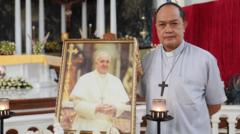On May 8, 2025, the Vatican's conclave remains inconclusive, with black smoke signaling that cardinals have not yet reached a decision. With diverse politics and fresh faces among the electors, the process is expected to be complex and prolonged.
Vatican Conclave's Second Day Marked by Continued Uncertainty

Vatican Conclave's Second Day Marked by Continued Uncertainty
The papal conclave enters its second day with cardinals facing challenges in selecting a successor to Pope Francis amid diverse views and heightened expectations.
The Vatican conclave continues on Thursday, May 8, 2025, as black smoke has emerged from the Sistine Chapel chimney, indicating that the cardinals have yet to reach a consensus on the election of a new pope after a lengthy voting session the previous evening. The first round of votes, which started after the papal master of ceremonies announced “extra omnes,” lasted over three hours and failed to yield a candidate worthy of a two-thirds majority from the 133 cardinals present.
As the crowds gathered around St. Peter's Square, tension rose as speculation grew regarding the causes of a delay in decision-making. Observers highlighted potential language barriers among the newer cardinals, coupled with a lengthy meditation prior to voting by the former preacher of the papal household, as contributing factors to the lengthy proceedings. The secrecy surrounding the conclave remains sacrosanct, with insiders bound by oaths limiting communication with the outside world.
Cardinals participating in this conclave face the complexity of their differing views, as many new faces appointed under Pope Francis potentially foster a more fragmented selection process. Previous elections have been fairly rapid, as both Pope Francis and Pope Benedict XVI were elected in just two days. However, some experts predict that the diversity among the cardinals may mean a longer conclave this time around.
Procedures dictate that four rounds of voting will occur each day until a candidate reaches the required two-thirds support. Each ballot is meticulously managed, with uncast votes symbolized by black smoke, while the announcement of a new pope would be marked by white smoke. As the next scheduled votes approach, the anticipation continues to grow among the faithful and observers alike, eager to witness the historical selection of the next leader of the Catholic Church.
As the crowds gathered around St. Peter's Square, tension rose as speculation grew regarding the causes of a delay in decision-making. Observers highlighted potential language barriers among the newer cardinals, coupled with a lengthy meditation prior to voting by the former preacher of the papal household, as contributing factors to the lengthy proceedings. The secrecy surrounding the conclave remains sacrosanct, with insiders bound by oaths limiting communication with the outside world.
Cardinals participating in this conclave face the complexity of their differing views, as many new faces appointed under Pope Francis potentially foster a more fragmented selection process. Previous elections have been fairly rapid, as both Pope Francis and Pope Benedict XVI were elected in just two days. However, some experts predict that the diversity among the cardinals may mean a longer conclave this time around.
Procedures dictate that four rounds of voting will occur each day until a candidate reaches the required two-thirds support. Each ballot is meticulously managed, with uncast votes symbolized by black smoke, while the announcement of a new pope would be marked by white smoke. As the next scheduled votes approach, the anticipation continues to grow among the faithful and observers alike, eager to witness the historical selection of the next leader of the Catholic Church.





















